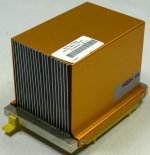The problem with CPU heatsinks that they must get forced air flow otherwise they work very poorly because of small gaps between fins. Using a fan leads to two problems - noise and dust.
This is true. Over on silentpcreview the results demonstrate that even a small fan makes a dramatic difference in cooling performance, as much as 10-20 degrees.
I noticed some people used the Zalman fans, but there's two things I don't like about them:
- They're about $30-$60
- Because most of them use heat pipes, drilling through the base could ruin the heatsink
- They use a relatively small fan, and small fans are noisy
I'm not a fan of the Pentium II and the Pentium III heatsinks because the fans are awful.
IMHO, the heatsinks that offer the best mix of price and performance are the Pentium IV Xeon heatsinks. These chips were BEASTS, drawing more power than today's Xeons. So the heatsinks are rather amazing.
An idea that I had is to buy square aluminum tubing, bolt the mosfets to the outside of the tube, and the heatsinks to the INSIDE. Then mount a fan on either end, one pushes and one pulls. This setup has some advantages for an amp:
With two fans, we have redundancy in the event of a failure- As you noted, convection is the key to these designs. Putting the heatsinks inside the tube reduces the volume of air, and increases airflow.
- This is fairly similar to how professional amplifiers work, I can upload a pic of one of mine if anyone wants to see it
- Xeon heatsinks are about $10. So you can get four for the price of a single Zalman, with much better cooling performance.
Attached is a pic of one from a Compaq DL380
Attachments
This is true. Over on silentpcreview the results demonstrate that even a small fan makes a dramatic difference in cooling performance, as much as 10-20 degrees.
I noticed some people used the Zalman fans, but there's two things I don't like about them:
- They're about $30-$60
- Because most of them use heat pipes, drilling through the base could ruin the heatsink
- They use a relatively small fan, and small fans are noisy
I'm not a fan of the Pentium II and the Pentium III heatsinks because the fans are awful.
IMHO, the heatsinks that offer the best mix of price and performance are the Pentium IV Xeon heatsinks. These chips were BEASTS, drawing more power than today's Xeons. So the heatsinks are rather amazing.
An idea that I had is to buy square aluminum tubing, bolt the mosfets to the outside of the tube, and the heatsinks to the INSIDE. Then mount a fan on either end, one pushes and one pulls. This setup has some advantages for an amp:
With two fans, we have redundancy in the event of a failure- As you noted, convection is the key to these designs. Putting the heatsinks inside the tube reduces the volume of air, and increases airflow.
- This is fairly similar to how professional amplifiers work, I can upload a pic of one of mine if anyone wants to see it
- Xeon heatsinks are about $10. So you can get four for the price of a single Zalman, with much better cooling performance.
Attached is a pic of one from a Compaq DL380
Pentium 4 heatsinks are there to do the job without a fan. Especially if you keep the fins vertically. They can be mounted so that the fins are exposed outside the amp cabinet. If put inside the cabinet they need not so much airflow if it's too hot. Running a 12V fan at 7.5-9 volts does all it needs without noise.
- Status
- This old topic is closed. If you want to reopen this topic, contact a moderator using the "Report Post" button.
